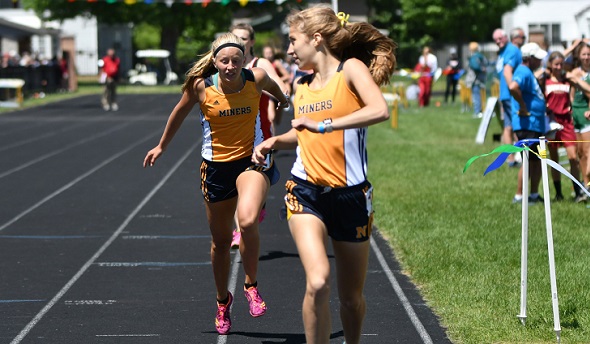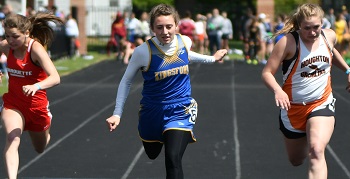
Speedy Pair Help Negaunee Pass Rival
By
John Vrancic
Special for MHSAA.com
June 2, 2018
KINGSFORD — Sophomore Emily Paupore and senior Clara Johnson provided the Negaunee girls with a potent 1-2 punch in the distance races Saturday, helping them earn their first Upper Peninsula Division 1 track title in eight years with 115 points.
With the win, the Miners also broke the seven-season championship streak for Marquette, which came in second this time with 89½ points. Kingsford was third with 84.
“This was a very exciting day,” said Negaunee coach Vickie Paupore. “At the beginning of the season we knew this was a special group of girls, and our seniors were excellent leaders and role models. They fought real hard. It was exciting to see Emily and Clara go 1-2 those races. It’s so inspiring to see the way they care about each other.”
Emily Paupore and Johnson helped the Miners open with a victory in the 3,200-meter relay in 10 minutes, 4.56 seconds. Paupore then captured the 800 (2:23.7), 1,600 (5:15.23) and set the U.P. meet record in the 3,200 (11:25.52), shaving 86 hundredths of a second off the previous record by Marquette’s Lindsey Rudden (11:26.38) in 2013.
“I’ll take anything if it’s a U.P. record,” said Emily, who also owns the school record in the 3,200 (11:11). “Being my fourth race, I knew it’d be tough.
“The past two years I’ve had so much support from Clara. It’s really sad to see she’s going.
“I always get butterflies before a race, which probably helped me in the 800. You can always build off that energy. I’m going to keep myself busy this summer with weight training and local road races to get ready for cross country. I love cross country. That’s my favorite.”
Johnson, who plans to play basketball at Michigan Tech next winter, was runner-up in the 800 (2:24.44), 1,600 (5:16.7) and 3,200 (12:01), all in personal-best times.
 “It was nice having somebody to train with the last two years,” said Johnson, who like Paupore was nearly overcome with emotion after their last high school race together. “There was a lot of pressure being the second seed because I knew there would be a lot of people coming after me. I did what I had to do to get second. I PRd, which is what you hope to do at the Finals, especially with this being my last one. In my junior year, I led Emily and pushed her to get better. This year she led and pushed me to get better.”
“It was nice having somebody to train with the last two years,” said Johnson, who like Paupore was nearly overcome with emotion after their last high school race together. “There was a lot of pressure being the second seed because I knew there would be a lot of people coming after me. I did what I had to do to get second. I PRd, which is what you hope to do at the Finals, especially with this being my last one. In my junior year, I led Emily and pushed her to get better. This year she led and pushed me to get better.”
Sophomore Chloe Norman, also part of the winning 3,200 relay, added a first in the 300 hurdles (47.78), second in high jump (4-8) and third in long jump (15-2½).
“Last year we set our school record in the 3,200 relay (9:46.91),” said Norman. “This time we just wanted to get a good place and conserve energy for other events.”
Marquette’s Rachel Hunt won long jump (15-2½), edging Houghton junior Anabel Needham by a half-inch. Hunt also helped the winning 800 relay (1:49.2) and was runner-up in the 200 (27.35).
Kingsford junior Olivia Allen took the 100 (13.09), retained her 200 (27.07) and 400 (59.51) titles and helped the Flivvers repeat as 1,600-meter relay champions (4:19).
“I’ve been working pretty hard on my starts, and I think I had one of my best starts in the 100,” said Allen. “It wasn’t perfect, but it gives me something to work on for next year.
“We had a great bunch of seniors who helped us so much. The weather was definitely on our side today. The breeze helped cool us off a little on the back stretch.”
PHOTOS: (Top) Negaunee’s Emily Paupore checks to make sure teammate Clara Johnson will finish second to her in a race Saturday; they came in first and second, respectively, in three events. (Middle) Kingsford’s Olivia Allen breaks across the line first in the 100-meter dash. (Photos by Cara Kamps. Click for more at RunMichigan.com.)

Track Gaining Speed Toward Future with Electronic Starting Devices
By
Steve Vedder
Special for MHSAA.com
May 23, 2023
Aubrey Greenfield thinks it might be the perfect time to reevaluate 130 years of tradition.
For a number of reasons, from technical to personal, the Oxford senior sprinter believes it makes sense for the crack of a starting pistol to be eliminated from high school track meets.
Because track meets would benefit in various ways from lowering costs to easier setup at meets to the human factor of competitors not having to flinch at the crack of a pistol shot, Greenfield believes the sport has a chance to embrace new technology – electronic starting devices (ESD).
In essence, an ESD replaces the starting pistol with a light flash, tone sound or both to begin a race.
"High school sports should put the athlete first," Greenfield said. "We should promote sports, and eliminating starting pistols promotes health in terms of PTSD or trauma for athletes and spectators and that would be good. I would like to think people would say that's a good idea."
In fact, Greenfield would go as far as to say if there was not an implementation of electronic starting devices, many of her teammates would have considered giving up the sport.
"If it's something that helps us compete safely, we're all for it," she said.
Greenfield's opinion apparently is spreading. Michigan High School Athletic Association senior assistant director Cody Inglis said the use of ESD makes it both affordable for meet starters and sensible for athletes and fans to rethink the use of starting pistols. While the MHSAA is not mandating electronic starting devices, it does promote the use of what Inglis calls "emerging technology." He notes that ESD are becoming the norm for organizations such as USA Track & Field, the NCAA and an increasing number of high schools.
 "I think we have to embrace new technology, and we think this will be something that takes hold," Inglis said.
"I think we have to embrace new technology, and we think this will be something that takes hold," Inglis said.
A key part of embracing ESD is the human element. The tragic Oxford High School shooting Nov. 30, 2021, that took the lives of four students while injuring seven others should not be relived even for a fleeting instance at a high school sporting event. Oxford athletic director Tony DeMare said the school began using ESD at every meet, including the MHSAA Lower Peninsula Division 1 Finals last June. He said that decision was embraced by virtually all schools Oxford encountered.
"We were very convinced that the alternative (of ESD) would promote a healthy attitude," DeMare said. "We were overwhelmed with the positive response. If a school was on the fence about it or might not be for it, I think we've started to see the tide turn in favor of people willing to listen and learn about electronic starting devices."
Inglis said the MHSAA is acutely aware of what the crack of a starting pistol can mean to athletes and fans.
"It's unimaginable what Oxford went through, and this is a small way we can help," he said. "We look at a (starting pistol) and think, ‘Could we do something else?’ It's a way of helping to solve a problem."
Over the last several years, the MHSAA has embraced finding an alternative to starting pistols. Inglis noted the discussion started with the cost and diminishing availability of 32-caliber ammunition that meet starters use. A box of ammunition, if it can be found, is around $75 a box.
In addition to cost, there is potential damage from excessive exposure to 150-plus decibels of sound generated by the traditional 32-caliber blanks. Medical studies show damage to ears caused by decibel levels above 120 dB.
The tragedy at Oxford accelerated the conversation.
Inglis said the cost of ESD can be likened to a school sinking money into artificial surfaces at football fields. Yes, there is a great cost at first, but over time money is ultimately saved. An ESD system itself ranges between $200 and $500. Speakers also may need to be purchased, but with ESD starting events like the 800 and 1,600-meter relays positioned near the outside lanes 8, 7, 6 and 5 would result in improved hearing by athletes at the start of a race.
There is one challenge with ESD that track administrators are working to overcome – lighting conditions that lessen the ability to see the ESD’s LED light or strobe when the button is pressed by a starter to begin a race. But that vision difficulty resulting from clear blue skies and backgrounds of setting suns can be substantially improved by incorporating a black background with an ESD – something as simple as a starter holding up black cardboard behind the lighting mechanism at the start of an event.
Inglis said when all factors are considered, the use of ESD makes sense.
 "With the climate we live in nowadays, no lookalike guns is good," he said. "We're not mandating this. But people are saying this is affordable."
"With the climate we live in nowadays, no lookalike guns is good," he said. "We're not mandating this. But people are saying this is affordable."
While switching to ESD would break 130 years of tradition, the timing could be a step forward, said Jeff Hollobaugh, co-author of the book "The Fleet Feet of Spring: Michigan's High School State Championships in Track & Field." He said while no definitive answer is possible, it's likely starting pistols were used at the inaugural state meet at the Jackson Fairgounds in 1895. The meet, which included events like tossing a 16-pound shot put, bike races and a 100-meter sprint, was sponsored by the Michigan Interscholastic Athletic Association (a predecessor to the MHSAA) and comprised mostly of the state's larger schools.
Hollobaugh's sentiments echo what many involved in today's high school track & field believe in terms of making a transition from starting pistols to electronic starting devices.
"It's a change, not necessarily good or bad, just different," he said. "It's not a drastic change, but it will take some getting used to. But it is the future. In the end, we'll all be fine."
DeMare believes the future of high school track will definitely include ESD.
"Our desire is that the practicality and sensibility of this will overcome the alternative," he said. "I think we'll see the automation and electronics taking hold of certain elements in track, and people will embrace it."
PHOTOS (Top) Runners watch official Bertha Smiley as they prepare to begin a race during last season's Lower Peninsula Division 1 Finals at Rockford. (Middle) An electronic starting device provided by VS Athletics was used to start those races. (Below) Smiley sets to begin an event. (Photos provided by David Kuderka/VS Athletics.)

